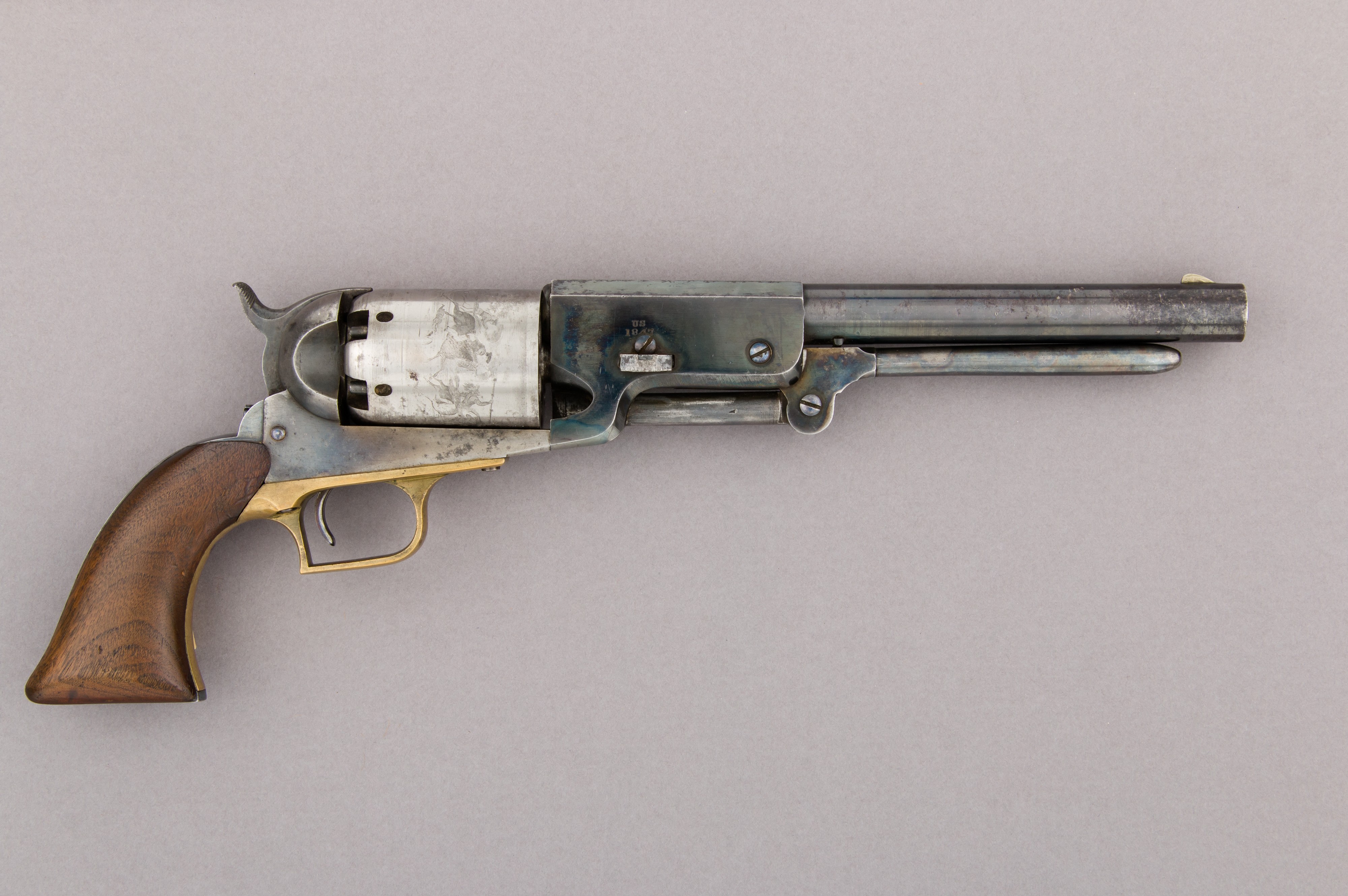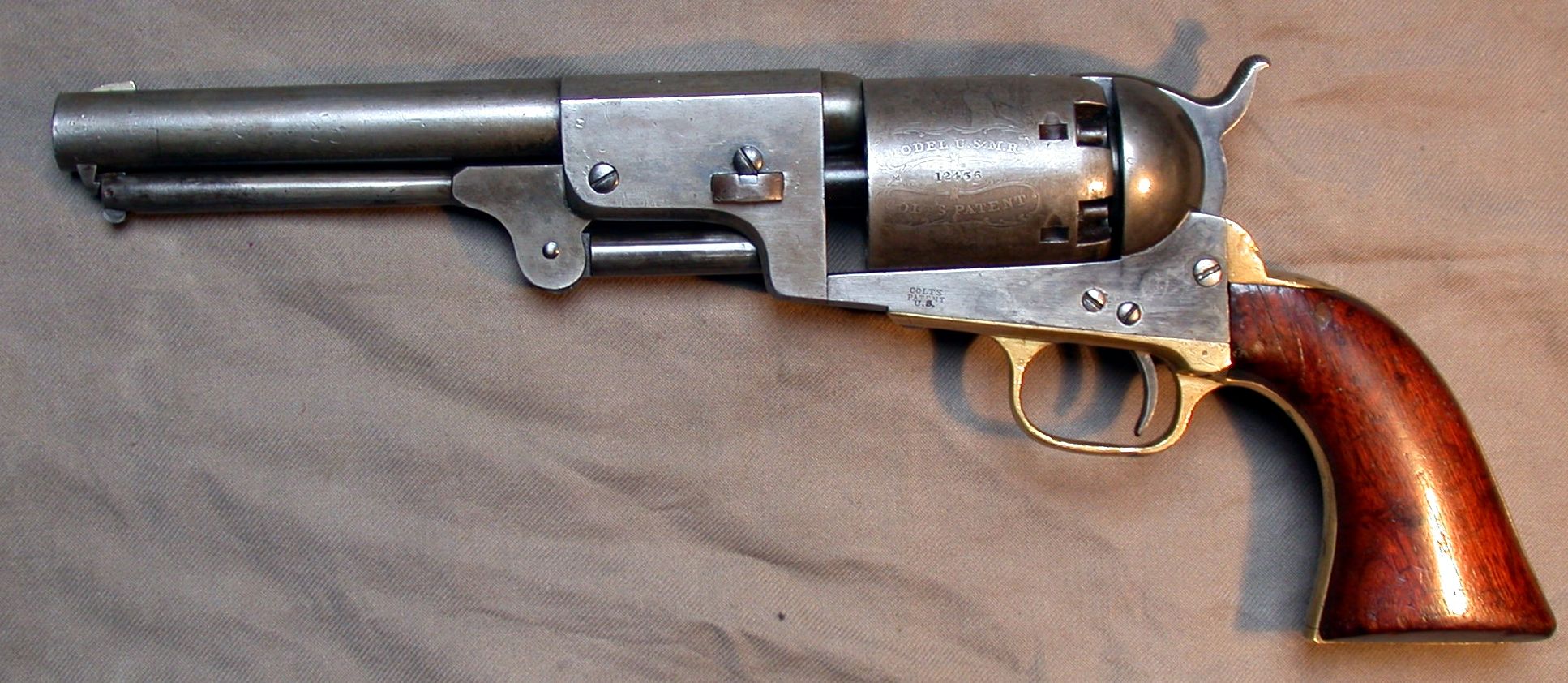
“God created man. Sam Colt made them equal.”
We’ve all heard this old saw a million times, because to many, Samuel Colt is the most important figure in firearms history. Even people who’ve never heard of Hiram Maxim, Eugene Stoner, or John Moses Browning know who Sam Colt is.
While Colt is certainly important, it’s not because he churned out a constant stream of gun innovations throughout his career, like Browning. By all accounts, he wasn’t a particularly good gunsmith. However, he was more of a varied inventor than many realize and should rightly be called an industrialist more than anything else. His method for building the revolvers he invented made him a true pioneer. He revolutionized the production of firearms and brought them to the masses, while creating one of the most successful gun companies in history.
His absolute greatest achievement was having the vision to create his first revolver, an important yet inevitable design, using interchangeable, machine-made parts. This allowed his guns to be the first built on an assembly line. Before that, every gun ever made had to be hand fit and finished by a practiced craftsman. The same went for replacement parts. In fact, Colt should get more credit for pioneering the use of the assembly line than Henry Ford. But, did you know he also built underwater mines, designed the first waterproof telegraph cable, or that he was once a traveling medicine man?
Fireworks and Laughing Gas
Colt’s younger years are like something out of a 19th-century adventure novel. Born in 1814, he had six siblings. His three sisters all died young; two of tuberculosis, like his mother, and one committed suicide. Two of his three brothers turned out fine, but one killed himself while awaiting execution for murder.
His father was in the textile business, and Sam learned how to use tools and work with various materials at his father’s factory. At 15, Colt was mostly interested in gunpowder and explosives. The kid liked blowing shit up. After being sent to boarding school, he impressed his classmates with homemade fireworks—that is, until a Fourth of July stunt started a fire and ended his tenure there. His dad was angry and sent him off to be a sailor.
As the legend goes, while on a journey to Calcutta, Colt had a lightbulb idea for a new revolver inspired by the ship’s windlass, a device with a ratchet-and-pawl mechanism. Multi-barrel pepperbox revolvers were popular at the time, but they were primitive and not very practical, requiring the user to manually rotate the barrels. They had no indexing mechanism or any way of ensuring the top barrel was properly aligned with the hammer—you just had to sort of guess and hope for the best.
While still aboard the ship, Colt carved a wooden model of a pepperbox gun with a hammer attached to a pawl. When you cocked it, the pawl turned the cylinder of barrels. The cylinder would then be locked in place by a bolt, aligning the top barrel with the hammer every time.
After returning to the U.S. in 1832, Colt was determined to build guns but needed capital. His father lent him enough to build a prototype rifle and revolver—the rifle sort of worked but the revolver exploded during test fire, and his pops was out.
Colt hit the road as a street performer, demonstrating the effects of the new-fangled “laughing gas” (nitrous oxide) across North America. He went by “The Celebrated Dr. Coult of New-York, London, and Calcutta.” He also did pyrotechnics for an artist’s successful wax figure tour of Dante’s “The Divine Comedy” in Cincinnati.
He made a bit of money and learned the art of the sale by taking his medicine show from street corners to auditoriums. Then Colt went all in, arranging partnerships with gunsmiths in Baltimore to build his ideas. This was probably a good call, considering the first pistol he built exploded. He gave up on the pepperbox design and went with a single fixed barrel and a rotating cylinder of chambers with an action that functioned similarly to his wooden model.

On Feb. 25, 1836, Colt patented his “revolving gun” in the U.S., which would later be built as the Colt Paterson. Here’s the thing—Colt didn’t invent the revolver and never claimed to have done so. The pepperbox existed for many years before Colt made his first guns.
Elisha Collier from Boston patented a revolving flintlock pistol in 1814. It had the familiar arrangement of a single fixed barrel with a rotating cylinder of chambers and was pretty popular for a time, especially in Europe. But it was complex, expensive, and relied on a flintlock action.
Colt’s design took Collier’s pistol a step further, making it more practical by incorporating Colt’s locking bolt mechanism, while also taking advantage of more reliable modern percussion caps. These are things other gunmakers and inventors would have undoubtedly come up with eventually, but Colt got there first. The most revolutionary invention was how Colt’s gun was built. Uniform, interchangeable parts and assembly line construction meant his revolvers could be produced inexpensively enough that average people could afford them.
He also had great timing. His patent gave Colt a monopoly on the revolver game in the U.S. until 1856, but it wasn’t enough at first. Sales were bad and, after a military contract fell through in 1843, Colt closed the Paterson, New Jersey, plant and auctioned off its assets.
Samuel Meets Samuel
Colt turned his attention to other ventures with a better chance of making him some money, including his first love: blowing stuff up.
He began selling underwater electrical detonators for mines and the waterproof cables he invented, teaming up with Samuel Morse to lobby the government for funding. Colt’s cable allowed Morse to run his telegraph lines under lakes, rivers, and bays. Morse used it in his attempts to lay lines beneath the Atlantic. While the wire had promise, Colt’s totally functional underwater mine was rejected by Rep. John Quincy Adams, who said it was an “unchristian contraption.”
Tinfoil Ammunition
That kick in the teeth sent Colt back to the gun world, this time on the ammo side. He set about perfecting tinfoil cartridges to replace the current paper cartridges, which held a pre-measured powder charge and a projectile in a paper tube or cone. Tinfoil proved far more resistant to water and moisture than paper, and Colt received an order from the Army in 1843 for 200,000 of his tinfoil cartridges in boxes of 10 for use in muskets. It was his biggest success yet.
He used the money to go back into business with Morse and throw himself into making the waterproof cable, for which he received a royalty on every mile laid. This gave him an income and allowed him to go back to working on revolvers. He commissioned a New York gunsmith to create a new design with improvements on the Paterson, including a stationary trigger. (The trigger on the Paterson came out of the frame when the gun was cocked. It had no trigger guard.)
Colt created the improved Colt Walker Revolver (aka the Walker Colt) with some suggestions from Capt. Samuel Walker of the Texas Rangers, who saw how useful Colt’s revolvers could be. Colt ultimately produced about 1,000 of these original Walkers and used the money from the sales to buy the necessary machinery and tooling to create the Colt’s Patent Fire-Arms Manufacturing Company in Hartford, Connecticut, and crank out guns for the government contracts that started rolling in.
The first guns produced here were known as Whitneyville-Hartford Dragoons and were assembled largely from leftover Walker parts. Subsequently, this first era of Colt pistols would be known as Dragoons and included improvements over the Walker model with each generation. All the while, Colt focused on keeping his prices below the competition and maximizing volume of sales, creating the best profit margins possible when haggling with officials over government contracts.

This was a time of great success for Colt but it’s also when he really missed the ball, perhaps because he was focusing on the business more than the guns. A Colt gunsmith, Rollin White, designed a “rear loading cylinder” that would work with the brand new metallic cartridges being made. Colt didn’t like one of his gunsmiths telling him how to improve his design, and gave White the brush-off. That turned out to be a big mistake.
White left Colt, patented his cylinder, and took it to another gun company called Smith & Wesson, which snapped it up and became the first company to make a metallic cartridge revolver. S&W’s ownership of the patent also blocked anyone else, including Colt, from producing metallic cartridge revolvers for 20 years. This didn’t really impact Colt as much as it should have. He made a whole lot more money from government contracts when the Colt 1851 Navy Revolver was adopted as the standard sidearm for U.S. military officers. And that’s about as far as the road of gun design went for Samuel Colt.
Questionable Ethics and Death
Colt demonstrated some rather unsavory business practices, sometimes exhibiting similar ethical standards to modern-day international arms dealers. He had a reputation for hawking guns to both sides of various conflicts in Europe and to both the North and the South in the years leading up to the American Civil War. Colt even thought about building an armory in the South in 1861 and sold 2,000 revolvers to John Forsyth after trade with the South was prohibited. Several prominent newspapers consequently labeled Colt a traitor to the Union. To combat this perception, the State of Connecticut commissioned Colt as a colonel, which is why you’ll sometimes see him referred to as Colonel Sam Colt. It was largely a PR stunt and he was discharged a couple months later, yet the moniker lived on.
Colt died from complications of gout the following year on Jan. 10, 1862. Though he’d been extremely successful and left an estate valued at $15 million ($348 million in 2019 dollars), he died more than a decade before his company’s most famous revolver was introduced and had absolutely nothing to do with its design. Still, his practicality and gun-building philosophy is clearly visible in the famed Colt Peacemaker/Single Action Army/M1873 revolver.

Sam Colt is undoubtedly a prominent figure in gun history. If not for him, the evolution of firearms during one of its most interesting eras may have gone a lot differently. Maybe the first successful repeating revolver would have been more like a Webley, or maybe even a lever-action design like the early Volcanic pistols. Maybe something like the Mauser C96 would have come along a few years earlier. More likely, revolvers like the Paterson and Walker would have arrived a little later and been more expensive until modern production methods were implemented.
Regardless, Colt was an innovator, inventor, a marketing and lobbying genius, and a great salesman. He created a network of sales reps all over the U.S. and abroad, who offered customers an array of customizable choices and options for their revolvers. He also made big shows of bestowing special Colts to famous and important people. In the gun world, Sam Colt practically invented branding and, while he was never a great gunsmith, he had the wisdom to hire people who were able to bring his ideas to life. He knew how guns should be built. It's important to recognize Sam Colt for his numerous real achievements, and not the ones that are products of marketing, though that’s somehow also appropriate.




Conversation